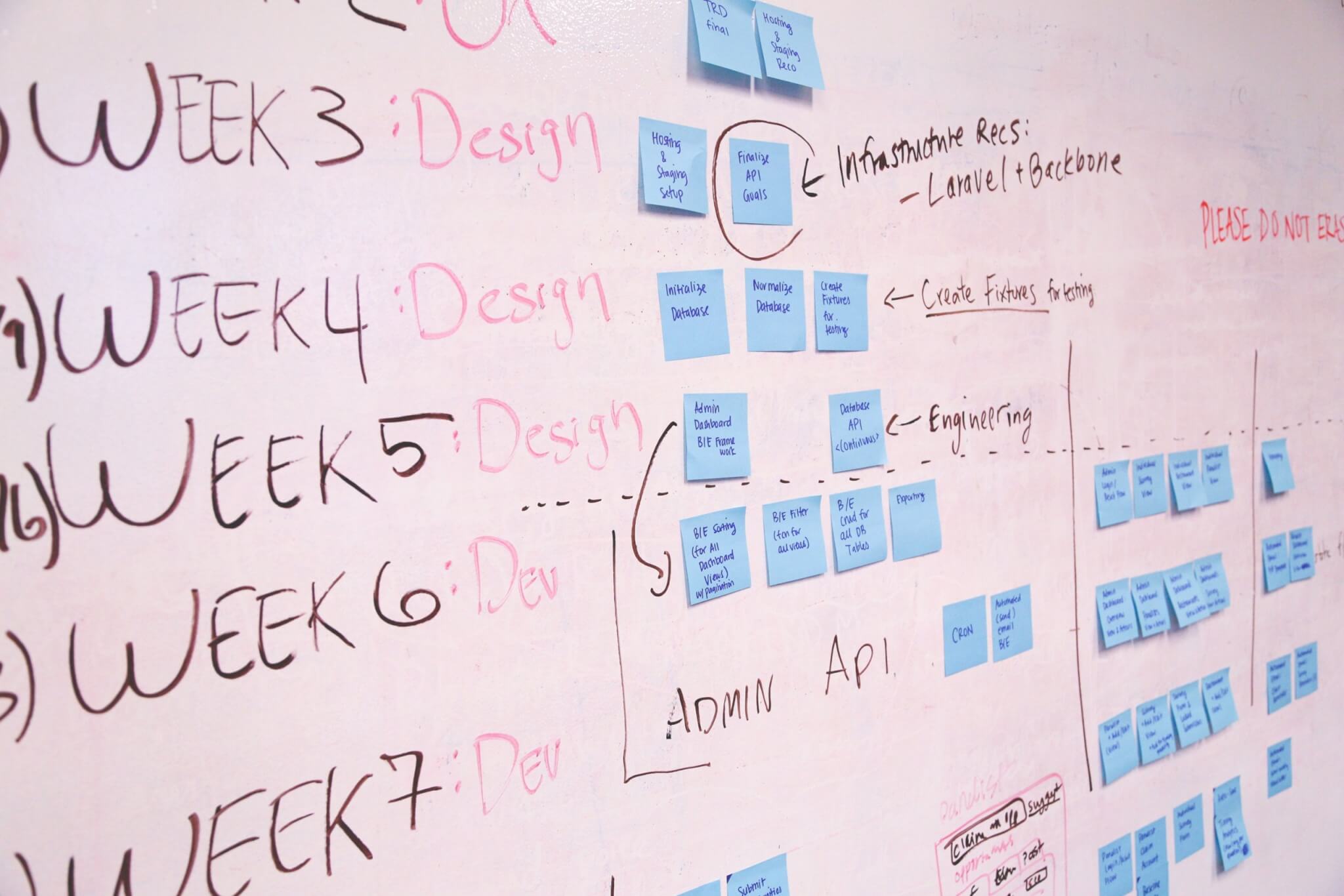If the team interaction boils down to sending messages and clicking buttons, it’s time to review the company’s communication policy. Even without jaw-dropping statistics, you know that poor communication impacts performance and causes company failures. What is a solution? Well-planned and held agile meetings. So you eliminate confusion and boost the collaboration quality of your team.
What Are Agile Meetings?
Agile meetings are razor-focused discussions, and each one has a clear objective to achieve. During these meetings, the team shares the key updates on the project, product manager or stakeholder feedback, customer feedback, and other vital updates.
Should You Implement the Agile Meetings?
Unlike the standard team meetings, agile meetings have a strict structure and purpose so that the attendees know what to expect and can prepare properly. The continuous team communication makes sprint planning more flexible and transparent, especially when dealing with large projects.
Who should use agile meetings? No matter what field you work in, agile meetings can bring you the following benefits:
- Better team collaboration
- Regular feedback
- Clearer goals and priorities
- Higher product quality
- Increased team accountability
- Enhanced team encouragement and satisfaction
Who Attends Agile Meetings?
The attendees of any meeting are a vital part of an effective meeting. Nevertheless, more people at the meeting doesn’t mean more profit. So be sure you are inviting people who actually can contribute value.
To produce valuable gains, enlist in your Agile meeting the following attendees:
- Product owner or product manager who decides what needs to be done and is in charge of the project
- Development team who are doing the work and turning ideas into reality
- Scrum master who ensures the Scrum meetings are productive and helps the scrum team, product owner, and company adopt Scrum
- Stakeholders who have an interest in the project
What Are the Types of Agile Meetings?
Agile meetings or Scrum ceremonies are an element of Scrum methodology. Scrum teams work in short timeframes called sprints and overview their progress during each sprint at agile meetings. The team members share their results and discuss further work so that nothing slips through the cracks. Depending on the sprint stage, different types of agile meetings take place. These include
- Sprint planning meeting
- Daily standup meeting
- Sprint review meeting
- Sprint retrospective meeting
- Backlog refinement/ meeting/backlog grooming meeting
Let’s find out what happens at each of these meetings.
Sprint Planning Meeting
- Why do project managers need it?
Sprint planning meetings help the team understand their tasks and priorities. As a result, everyone understands the sprint’s goal and knows what to focus on before the sprint starts.
- Who attends it?
The project manager, development team, and Scrum master.
- What happens at this agile meeting?
The project manager represents the product backlog, assigns tasks, and sets deadlines. The product backlog should contain the list of bug fixes, user stories, and project requirements to implement during the sprint. During this meeting, the members define a realistic goal for the upcoming sprint.
- How long it lasts?
Sprint planning meetings take 2-4 hours if your sprint lasts 1-2 weeks, correspondingly.
Daily Standup Meeting
- Why do project managers need it?
Daily stand-ups keep everyone in the loop and help resolve bottlenecks on the spot. As the name suggests, the participants stand up when talking to draw attention. This practice increases the team’s accountability.
- Who attends it?
The Scrum master and the development team.
- What happens at this agile meeting?
The team members share their completed tasks, plans for today, and the difficulties hampering their progress, if there are any. The Scrum master estimates their results and helps eliminate the blockers.
- How long it lasts?
The daily stand-up is the shortest agile meeting and lasts up to 15 minutes.
Sprint Review Meeting
- Why do project managers need it?
The sprint review meeting sums up everyone’s accomplishments during the sprint and helps stakeholders check how the progress aligns with the project guidelines.
- Who attends it?
Everyone who works on a project or is interested in it: the product manager, Scrum master, development team, and stakeholders.
- What happens at this agile meeting?
The team presents the work done - the backlog items completed during the sprint. They discuss each item and give and get feedback about it. The participants estimate the progress and define the ways to optimize collaboration in future sprints.
- How long it lasts?
The sprint review meeting involves much discussion, which takes 2-4 hours.
Sprint Retrospective Meeting
- Why do project managers need it
The sprint retrospective meeting helps identify the shortcomings of the last sprint so that the next sprint is more efficient. Even if the last sprint is a success, scrum teams hold such meetings to make a general sum-up and consider possible improvements.
- Who attends it?
The Scrum master, product owner, and development team.
- What happens at this agile meeting?
The team members analyze the good & bad of the last sprint and decide how to address the bad during the next sprint. Did the team collaborate enough? What tasks were the toughest? What goals were achieved? What needs deeper attention? The sprint retrospective meeting answers all these questions.
- How long it lasts?
It is commonly allowed to spend up to 45 minutes per sprint week.
Backlog Refinement Meeting
- Why do project managers need it?
Though this type of agile meeting is optional, most scrum teams add it to their agenda. It usually occurs before the end of the sprint to review the backlog items. The backlog refinement meeting’s purpose is to reevaluate the priorities and define the work left.
- Who attends it?
The developers, Scrum master, and product owner.
- What happens at this agile meeting?
The participants prioritize product backlog items, detect inconsistencies, and make adjustments—some items might need clarification, while others might be removed or postponed. The outcome is a detailed list of user stories to implement till the end of the current sprint.
- How long it lasts?
The backlog refinement meeting lasts up to 30 minutes. Still, those half an hour can significantly affect the product delivery.
| Sprint Planning Meeting | Daily Standup Meeting | Sprint Review Meeting | Sprint Retrospective Meeting | Backlog Refinement Meeting | |
| Why do project managers need it? | It helps define a realistic sprint goal. | It keeps the team updated and increases accountability. | It helps estimate the team’s performance during the sprint. | It helps avoid repeating mistakes during the next sprints. | It keeps the product backlog relevant across the sprint. |
| Who attends it? | Project manager, development team, Scrum master | Scrum master, development team | Product manager, Scrum master, development team, stakeholders | Scrum master, product owner, development team | Developers, Scrum master, product owner |
| What happens at this agile meeting? | The project manager outlines the product backlog and assigns tasks. The team defines the sprint goal. | The team shares their results with the Scrum master who estimates their progress and gives advice. | The team demonstrates their completed tasks and discusses future collaboration. | The team reviews their performance during the last sprint and finds solutions to improve it in the future. | The attendees re-evaluate product backlog items and make adjustments. |
| How long it lasts? | 2-4 hours | Up to 15 minutes | 2-4 hours | Up to 45 minutes per sprint week | Up to 30 minutes |
Six Top Agile Meetings' Best Practices for Scrum Teams
The art of agile meetings needs cultivation. Several good practices can help scrum teams succeed in this matter. So, what to keep in mind?
#1 Stick to Scrum Ceremonies
Make your project cycles consistent by holding the Scrum ceremonies discussed above. Note that you should strictly adhere to their sequence - one missed meeting can reduce the quality of other meetings to zero.
#2 Plan the Meeting Agenda
Enlist the meeting agenda beforehand and share it with participants to prepare them for discussion. This practice helps stay focused on the topic and talk things over within a shorter time.
#3 Invite Collaborators and Stakeholders
Meetings in agile should unite everyone dealing with the project so each member can speak and hear others. If there’s enough communication, you prevent misunderstandings and save time on reworking.
#4 Stay Focused on Your Goal
Conversations during agile meetings are highly focused, so stick to the meeting’s purpose. Wandering off the topic will make the conversation complex and unnecessarily long.
#5 Create Meeting Minutes
Take notes of what’s been discussed during the meeting and share them with others. In other words, create meeting minutes. These records help you keep the conversation on track and are a reminder for the participants.
#6 Use Project Management Tools
Agile meetings get more efficient if you use project management tools. Features like whiteboards, docs, Gantt charts and Kanban boards help you visualize information in a comprehensive way.
How Can Project Management Software Improve Agile Meetings?
Let’s dig deeper into the benefits of hosting agile meetings with project management tools. Why is it important? Agile project management software assembles features essential for product development and agile meetings in particular. Read on and find them out.
Sprint Planning Templates
Creating sprint plans from scratch each time can be exhausting. Why waste time if there are sprint planning templates? Usually, those look like Gantt charts, so you can arrange tasks against a timeline, set dependencies and deadlines, and track progress. You can share this document with others to make your agile meeting more transparent.
Project Overview
During an agile meeting, you keep a lot of information in mind. If notes are not enough, consider the project overview tool. It provides a snapshot of your project, including project status, completed tasks, and milestones.
Goals
Make goals visible and trackable with project management tools. The Goals feature allows you to connect tasks to particular goals, set targets, and track progress against each goal.
Board View
Like using sticky notes? The Board View shows you all tasks within the sprint in the form of virtual sticky notes. You can check the status, description, and assignee of each task. Typically, it’s a Kanban board with a drag-and-drop function.
Custom Permissions
Some meetings in agile can involve a small circle of people. By setting custom permissions, you can make sure to stick to your company’s policies. For instance, who can edit or delete items? Or who can add new members? Decide that with product management software.
Burndown Chart
A picture is worth a thousand words, right? A burndown chart shows how much work is left against time. It predicts how your progress will look if you keep on working at the same speed. This tool comes in handy during the sprint reviews and backlog refinement meetings.
Seven Best Meeting Management Software
When choosing your best meeting management software, don’t miss these tools:
- ClickUp
- Wrike
- Asana
- Zoho Projects
- Trello
- Jira Software
- Monday.com
Let’s figure out how these solutions can benefit your online meeting management.
How to Use ClickUp for Meetings in Agile?
ClickUp is project management software that helps agile teams track their results and increase productivity. Use it to create meeting minutes, manage meeting cadence, and visualize data with project views and boards.
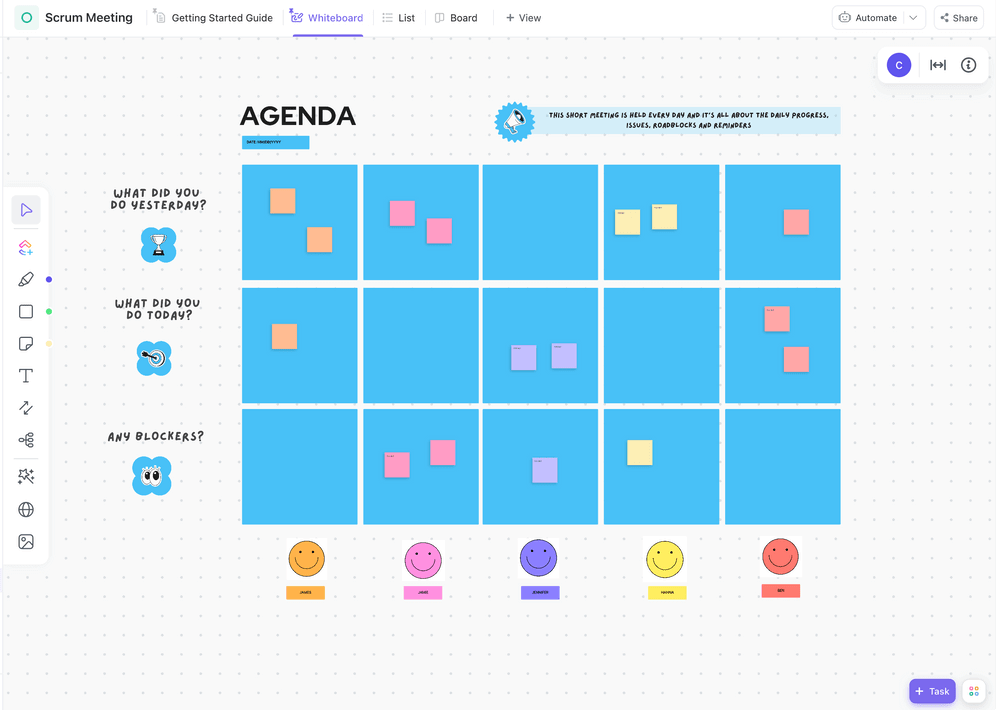
Source: ClickUp
To manage scrum teams, ClickUp lets you set up sprints, make time estimates, link tasks in Gantt charts, and track progress using dashboards.
What Are Wrike’s Meeting Management Features?
Wrike makes team meetings more productive with templates for meeting agendas, actionable meeting notes, and meeting minutes. It simplifies sprint planning with Gantt charts and brings shared calendars to schedule recurring meetings.
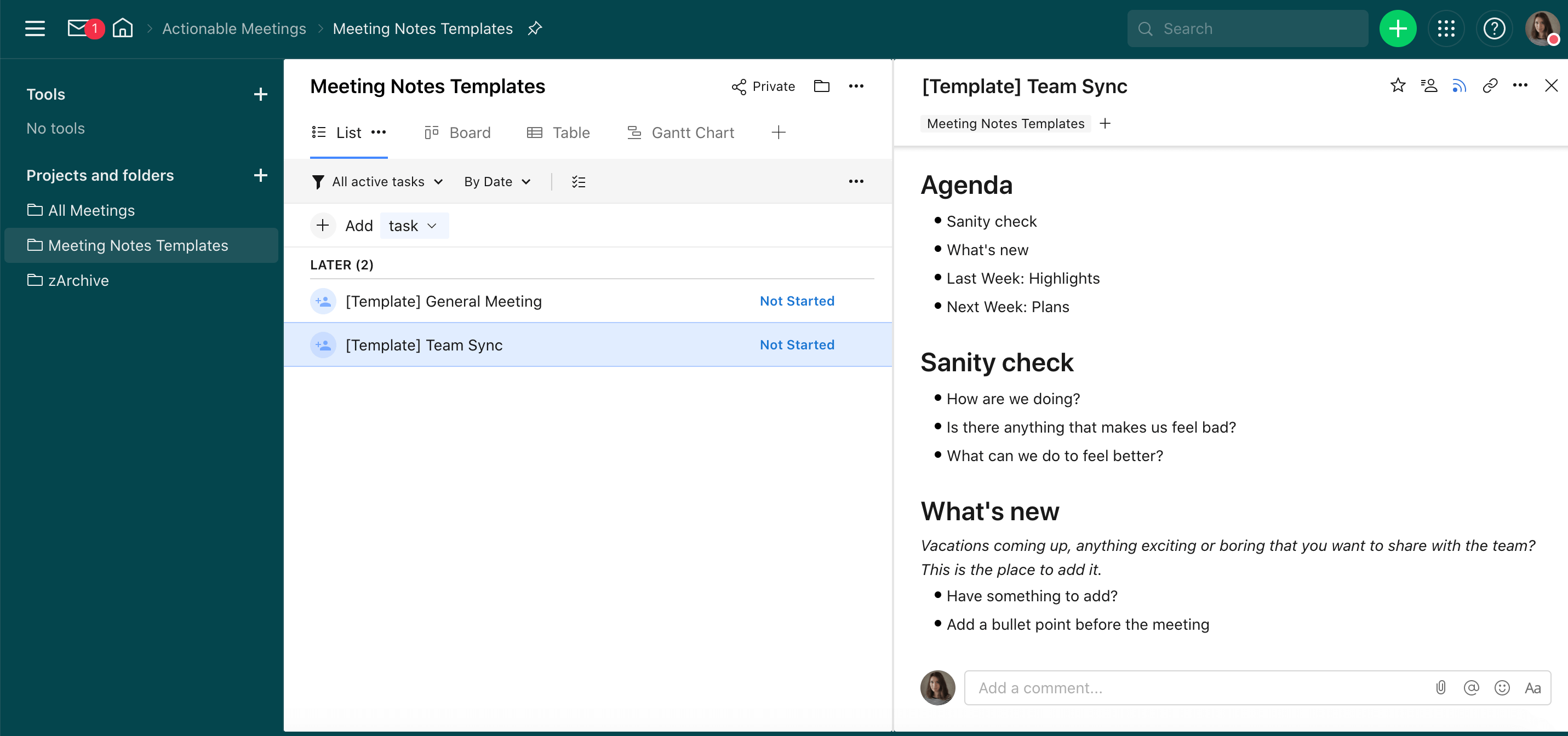
Source: Wrike
Wrike’s reports and dashboards keep everyone tuned, while live document editing encourages collaboration.
Is Asana the Best Meeting Management Software?
Asana is a project management system providing a powerful toolset for agile teams. It allows you to create project portfolios, manage product backlogs, plan sprints, and stay on top of your progress. How to use it for an agile meeting?
- Use meeting agenda templates
- Write notes for Scrum meetings
- Create meeting minutes
- Link Goals to projects and portfolios
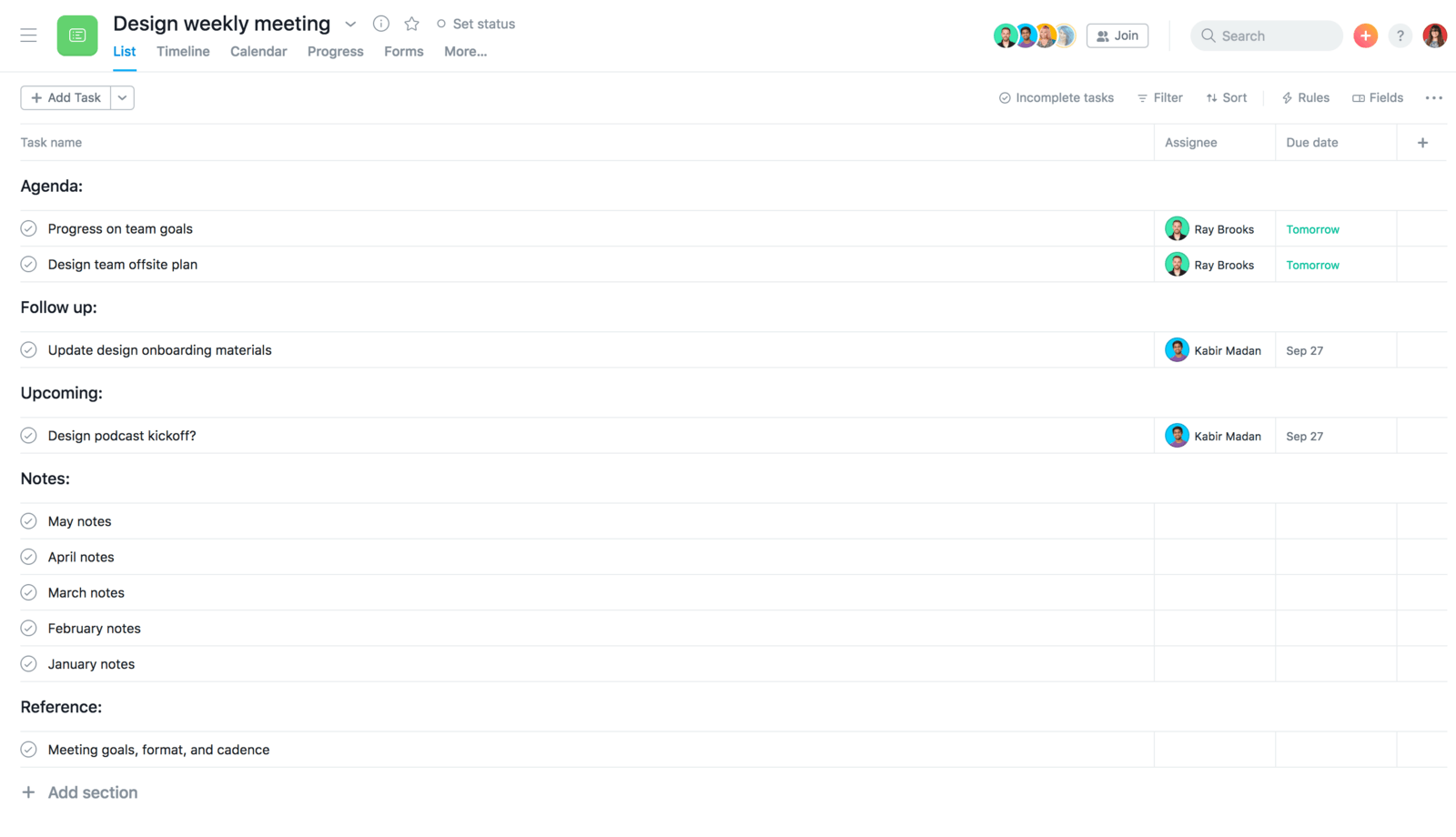
Source: Asana
Is Zoho Projects Good for Meetings?
Zoho Projects offers the Zoho Meeting integration to schedule meetings, invite internal and external stakeholders, start meetings from feeds, calendars, or reminders, record meetings, and generate attendee reports.
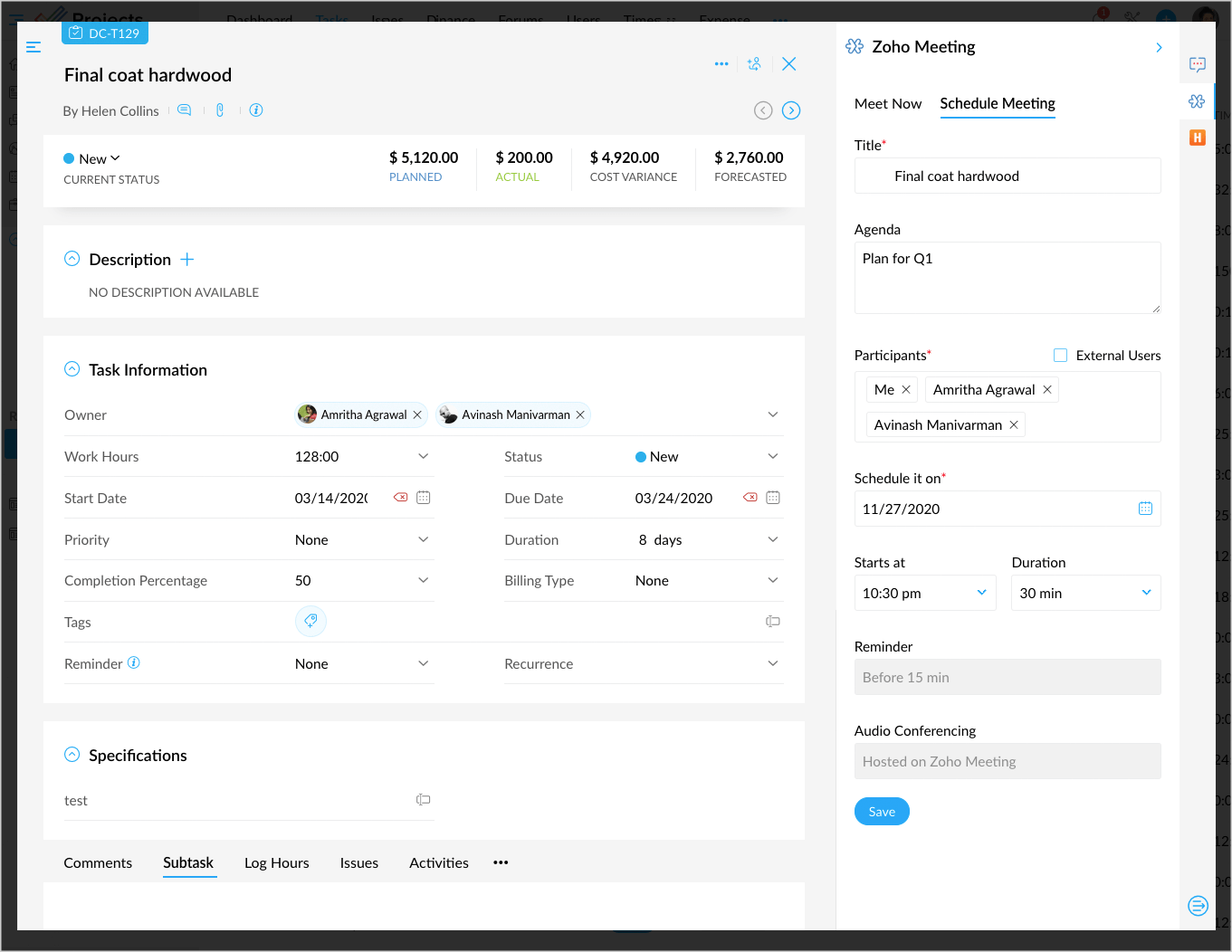
Source: Zoho Projects
Plus, the Zoho Sprints tool provides a Scrum board, backlog, and charts to track team productivity.
How Does Trello Comply with Agile Meeting’s Best Practices?
With Trello, you can arrange cross-company meetings of any size and automate repetitive tasks like creating meeting agendas, inviting members, and tracking due dates. You can stay focused using meeting checklists and collect topics with Trello boards.
In Trello, you can visualize sprints using views such as Dashboard, Timeline, or Workspace Table and add clarity with colored labels.
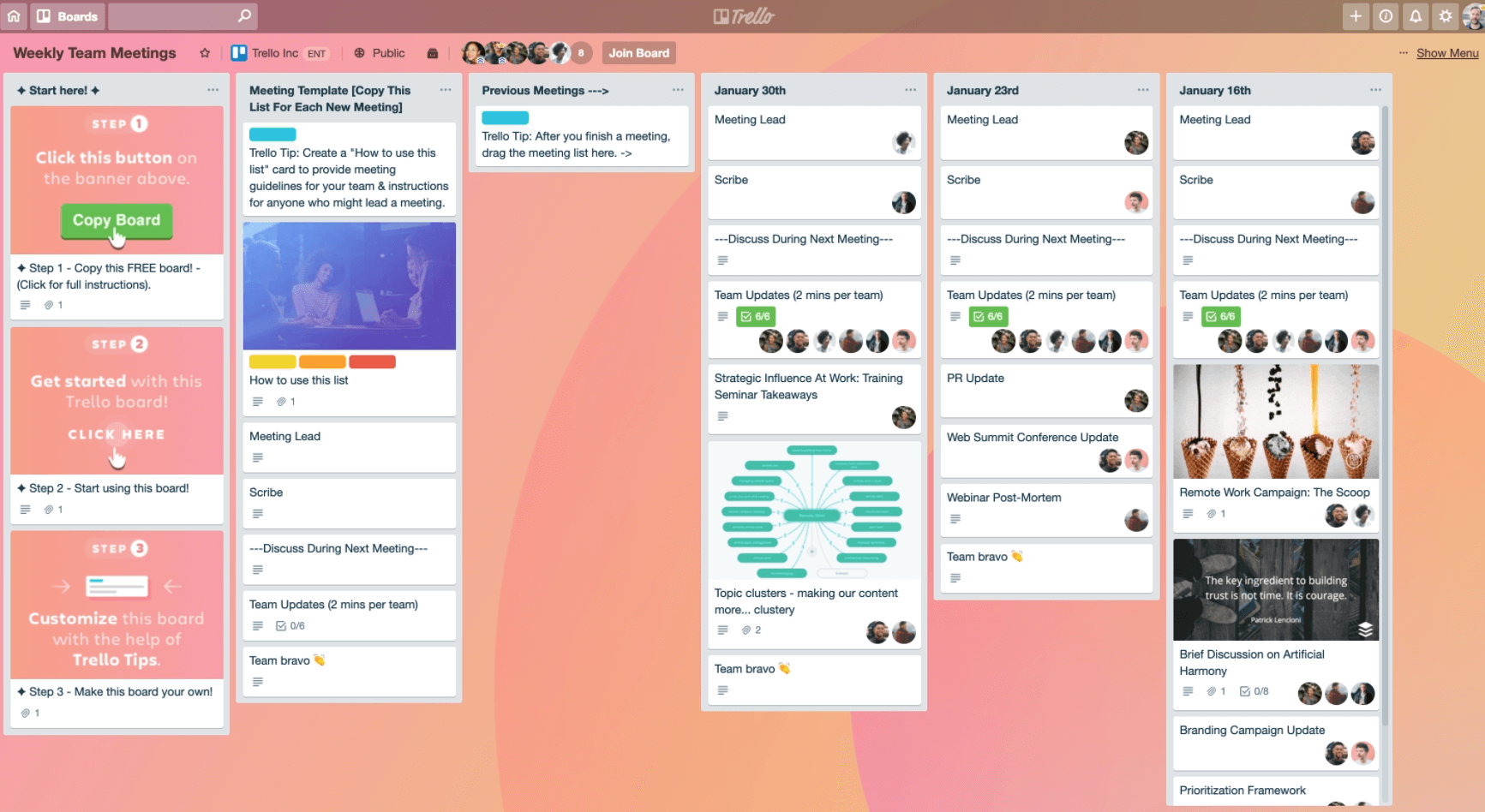
Source: Trello
Does Jira Software Outstand Among Other Meeting Software?
Many agile teams choose Jira Software to plan, manage, and release products. You can use it to create scrum projects, add items to the backlog, plan sprints, and run meetings.
Jira Software provides templates for meetings like Daily Stand-Up, Meeting Notes, Stakeholder Communications, 4LS Retrospective, and more.
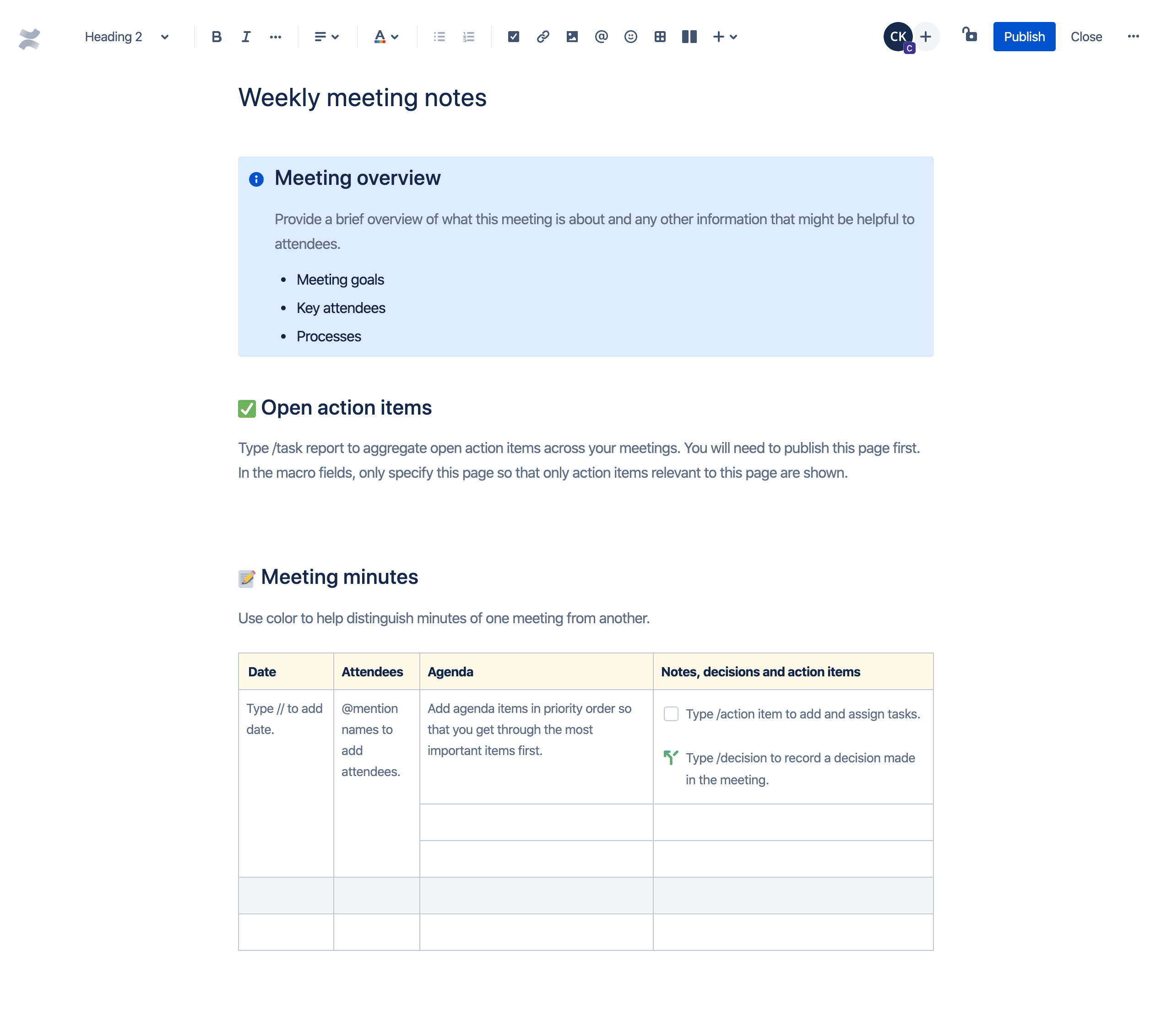
Source: Jira Software
Also, Jira offers plugins to schedule and host meetings within Jira, create meeting minutes, and add meeting rooms and locations.
What Is Meeting Management on Monday.com?
Monday.com project management software brings robust visualization possibilities. It offers customizable templates to represent your project as you prefer, including Sprint Retrospective, Product Development, Features & Releases Roadmap, and more.
To improve your team meeting, you can use Monday’s templates for meeting minutes and agendas, highlight data with dashboards, and visualize projects with views, including Calendar and Canban.
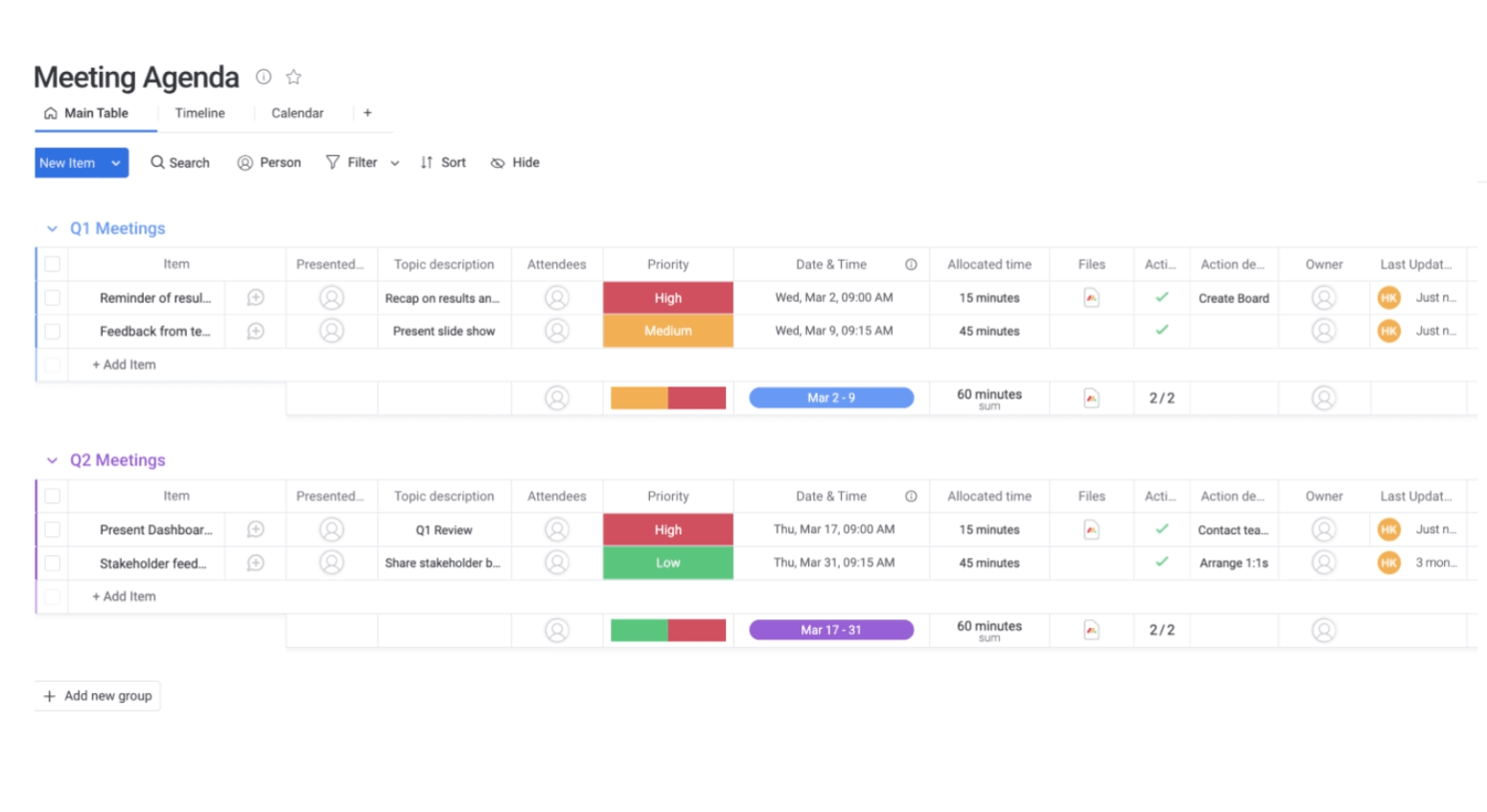
Source: Monday
How to Improve Agile Meeting Management?
Agile meetings are efficient as long as you ensure everyone understands everything. The above agile meetings' best practices and the right project management software will make your team succeed. Be sure this project management trend is beyond time!
Want to migrate to agile meeting software?
Let's migrate PM data together!
